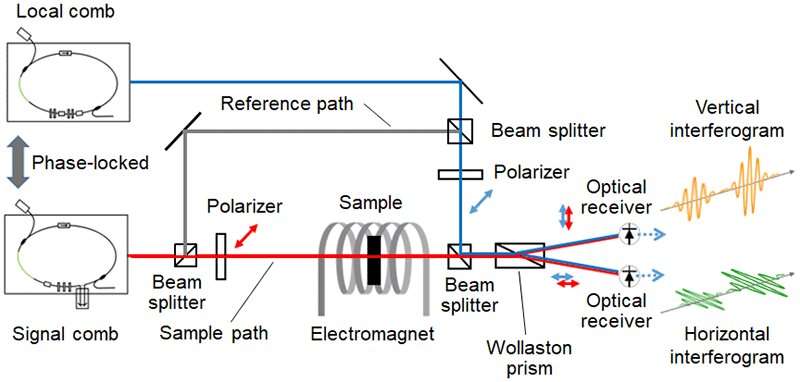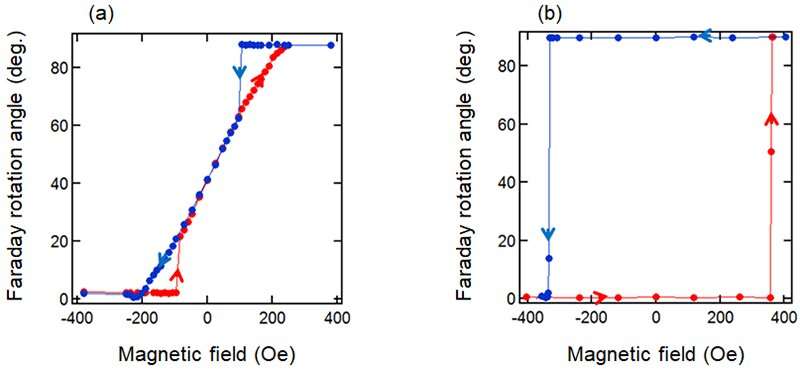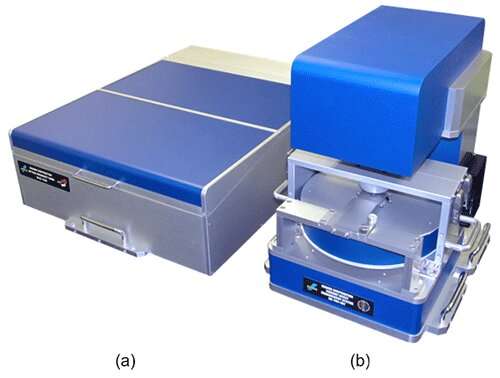Development of magneto-optic effect measurement device using dual-comb spectroscopy

Professor Kaoru Minoshima from the University of Electro-Communications and NEOARK Corporation have succeeded in prototyping a greatly improved magneto-optic effect measurement device as part of the ERATO MINOSHIMIA Intelligent Optical Synthesizer Project, under the JST Strategic Basic Research Programs. An exhibition of the prototype device is planned for the Science Photonics Fair 2019 being held at the Science Museum from November 12 to 14, 2019.
Dual-comb spectroscopy is a new spectroscopy that uses two precisely controlled ultrashort pulse lasers, known as optical frequency combs (optical combs). Dual-comb spectroscopy offers major improvements over conventional Fourier spectroscopy in areas including resolution, sensitivity and measuring time. Thus far, dual-comb spectroscopy has primarily been used for gas spectroscopy. The project that is the first in the world to develop a solid physical property evaluation technology using dual-comb spectroscopyy, has demonstrated the principles in various physical property measurements.
As a first step in developing practical applications of the technique, Professor Minoshima and her colleagues developed a magneto-optic effect measurement device capable of evaluating the characteristics of magnetic materials. The optical system and signal detection system of the prototype were improved to achieve measurement performance that greatly exceeds conventional measurement methods.
The prototype achieved major progress towards practical application, featuring a magneto-optic effect measurement resolution of 0.01 degree, a wavelength resolution of 0.01 nanometer, capable of high-speed measurement through batch measurements of all wavelength components. The prototype is a desktop system, consisting of a measurement unit, a dual-comb light source, and a controller. The generated magnetic field is a maximum of ± 10 kilo-Oersted.
-

Fig.2 Magnetic field dependence of the Faraday rotation angle measured by the dual-comb magneto-optical effect measurement system. Magnetic hysteresis observed in (a) soft and (b) hard magnetic materials using the dual-comb system. Red and blue points are the measured data when increasing and decreasing the magnetic field, respectively. Credit: The University of Electro-Communications, Kaoru Minoshima, and NEOARK -

Fig.3 Prototype of the dual-comb magneto-optical effect measurement system. (a)Dual-comb light source with a width of 470 mm, a length of 600 mm, a height of 180 mm, and a weight of 12 kg. (b)Measurement unit with a width of 260 mm, a length of 360 mm, a height of 400 mm, and a weight of 35 kg. Maximum induced magnetic field is ± 10 kOe. Credit: The University of Electro-Communications, Kaoru Minoshima, and NEOARK
Furthermore, based on the above-mentioned solid physical property evaluation technology, the research team also developed a prototype device for measuring the complex refractive index of solids. A major feature of the prototype is its capability to measure the phase difference of light in addition to its intensity ratio.
Measurement devices leveraging dual-comb spectroscopy for magneto-optic effect measurement and complex refractive index measurement are expected to become important new tools for the precise measurement of polarization and spectroscopy, and for the material development. They will proceed with development targeting commercialization in the near future.
Provided by University of Electro Communications




















